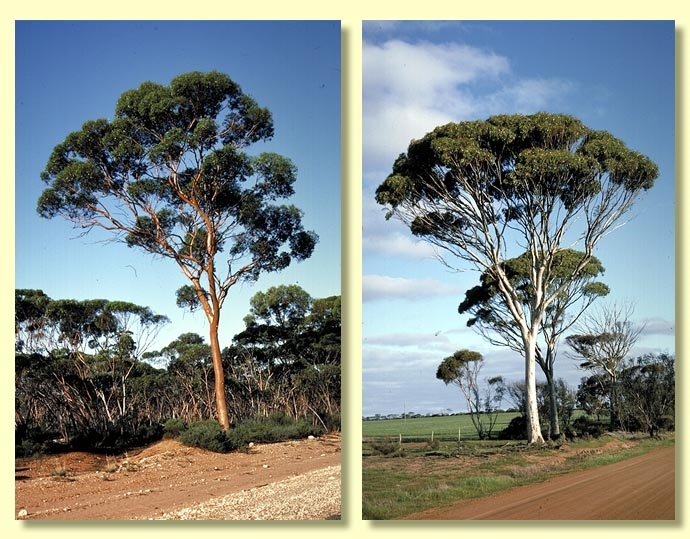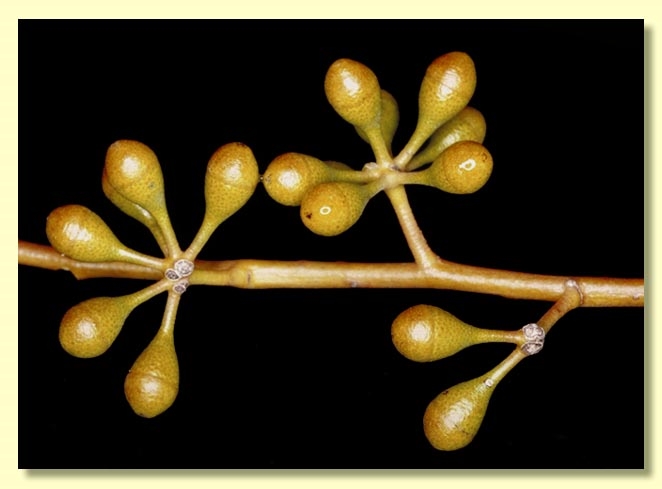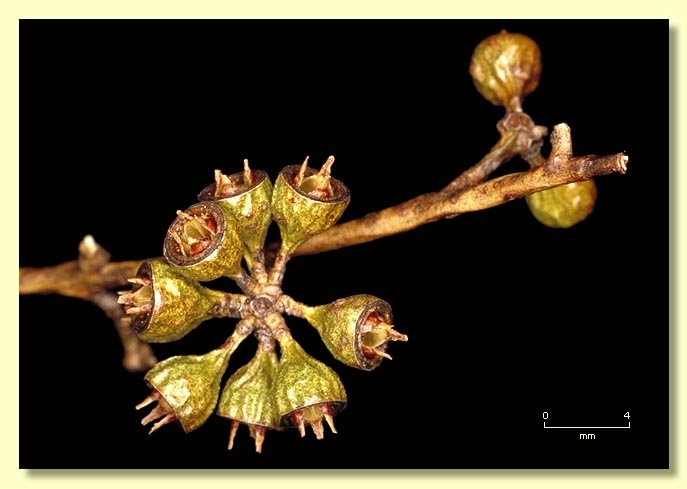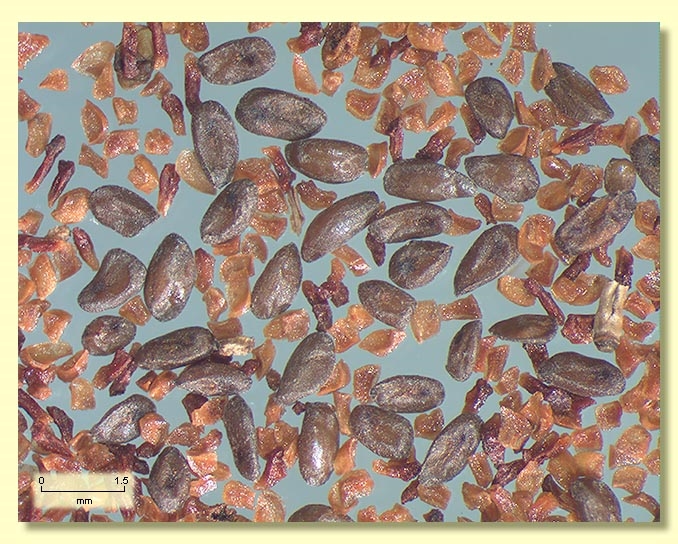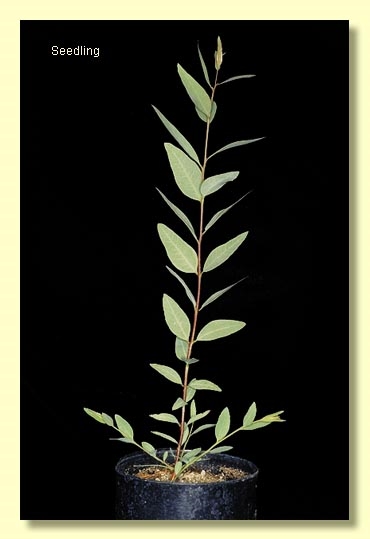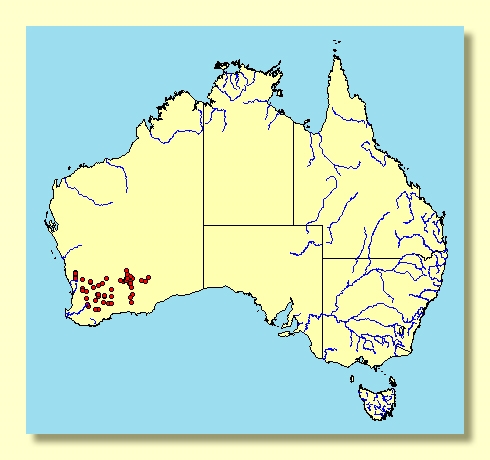Euclid - Online edition
Eucalyptus salmonophloia
Eucalyptus | Symphyomyrtus | Bisectae | Destitutae | Salmonophloiae
T: a number of syntypes, including: Upper Swan R., W.A., Nov. 1877, F.Mueller s.n.; syn: MEL; isosyn: NSW; near York, W.A., Nov. 1887, F.Mueller s.n.; syn: MEL; beyond York, W.A., Nov. 1887, F.Mueller s.n.; syn: MEL.
Bark smooth throughout, pale grey over salmon-pink to cream, shedding in flakes.
Branchlets lacking oil glands in the pith.
Juvenile growth (coppice or field seedlings to 50 cm): stems rounded in cross-section; juvenile leaves always petiolate, opposite for up to ca 10 nodes then becoming alternate, ovate to broadly lanceolate, 7–9 cm long, 1.2–3 cm wide, green to grey-green, dull.
Adult leaves alternate, petioles 0.7–2 cm long; blade narrowly lanceolate to falcate, 6–12 cm long, 0.6–1.7 cm wide, base tapering to petiole, margin entire, apex finely acuminate, very glossy, green, concolorous, side-veins at an acute or wider angle to midrib, reticulation dense to very dense, intramarginal vein close to or remote from margin, oil glands round, intersectional.
Inflorescence axillary unbranched, peduncles 0.4–1.3 cm long, buds (?)9 to 13, pedicellate (pedicels 0.2–0.4 cm long). Mature buds globular to ovoid (0.4–0.7 cm long, 0.3–0.4 cm wide), scar present, operculum rounded to conical, stamens irregularly flexed, anthers globular to cuboid, scarcely versatile, basifixed, dehiscing by short lateral slits, style long and straight, stigma more or less blunt, locules 3, the placentae each with 4 vertical rows of ovules. Flowers creamy white.
Fruit pedicellate (pedicels 0.2–0.4 cm long), hemispherical to slightly obconical, 0.3–0.5 cm long, (0.3)0.4–0.5 cm wide, disc narrow, descending, valves 3, exserted, fragile.
Seeds brown, 0.8–2 mm long, flattened-ovoid, dorsal surface smooth, hilum ventral.
Cultivated seedlings (measured at node 10): cotyledons Y-shaped (bisected); stems square to rounded in cross-section, more or less smooth; leaves sessile to sub-sessile and linear for 2 or 3 nodes, opposite for 11–13 nodes then becoming alternate, shortly petiolate, ovate to elliptical, 3.5–8 cm long, 0.8–2.3 cm wide, dull, grey-green to green.
Flowering has been recorded in January, February, May, August, September and October.
The wood of E. salmonophloia is very strong and durable and was once used extensively for mining timber, firewood and railway sleepers, now much depleted over its natural range.
A small to medium-sized tree endemic to Western Australia, very common and widespread in the wheatbelt and goldfields, from the eastern Darling Range to Cundeelee east of Kalgoorlie. The bark is smooth, pale grey and cream in winter and spring and conspicuously salmon-coloured in summer and autumn. The adult leaves are very glossy, green.
Eucalyptus salmonophloia belongs in Eucalyptus subgenus Symphyomyrtus section Bisectae subsection Destitutae because buds have two opercula, cotyledons are Y-shaped and branchlets lack oil glands in the pith. Within this subsection, however, E. salmonophloia has no close relatives. It is the only species in the series Salmonophloiae but has been associated with series Subulatae, although the similarities could be superficial and convergent. The fruit of E. salmonophloia has broad-based valves derived from the exposed roof of the shallowly positioned ovary. This distinguishes E. salmonophloia from species in series Subulatae. The ovary in fruit of series Subulatae is deeply sunk in the hypanthium and the visible parts of the valves in dehisced fruit are actually remnants of the style.
Within its natural range E. salmonophloia superficially resembles two tree species in series Porantherae, E. kumarlensis and E. salicola. Both of these have sessile juvenile leaves that are linear and orbicular respectively, whilst those of Salmon Gum are always petiolate, ovate and much larger. Eucalyptus salmonophloia also has more globular buds that are never beaked.
Salmon Gum is a striking tree, often surprisingly tall in the low rainfall eastern part of its distribution.

